

304. $1200
E. Howard Banjo No. 5, ca. 1874. The smallest of the Howard banjos at 29 inches high, in “well-seasoned
hardwood, stained in imitation of rosewood, and polished. For use in dwelling-houses, offices and rooms, they are well adapted.” This clock retains the rosewood staining quite nicely; all three glasses are old, possibly repainted, possibly rebacked. There
is some lifting of the black background paint in the throat section. The dial was probably repainted some time ago as it shows
age. The hands are correct. The movement is signed and running, driven by an appropriate weight. There is a weight
shield, a pendulum tie-down, and an instruction label on the bottom. The damascened pendulum bob is old, the pendulum stick
may be new. There are screws securing the base to the case where the weight may have knocked it off. All in all a better
than average example particularly with regard to the grain painted finish, which is often worn off. A couple of sales on eBay
in 2016, both over $1500. $1400-$1800.
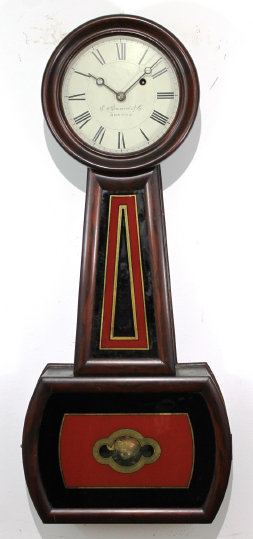
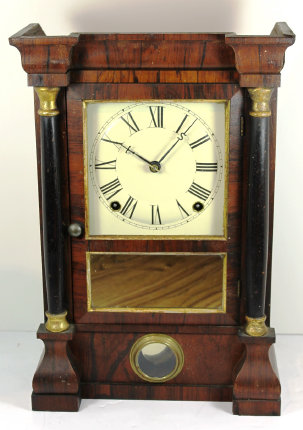
305. $100
Seth Thomas Column, ca. 1870. Sometimes called the Column Porthole, this little 8-day clock is only
16 inches tall and fits on almost any shelf. A classic model, almost always seen as here with a mirror in the middle, black
painted columns with gold leaf capitals and bases, and gold leaf trim around the glasses. The rosewood veneer is better than
average, with just one missing piece on the right foot; the case could use a coat of wax. The glasses are old, including the
mirror, the metal dial has been repainted, the hands are correct. The 8-day Seth Thomas lyre movement, signed from Plymouth,
retains its winding stops and is running and striking on a wire gong as expected. There is a good Thomaston label inside. Nothing to complain about here, a popular clock from the late 1800’s. $100-$150.
306. $125
Sessions “Sentinel”, 1910. A 24-inch by 16.5-inch case in oak, dark with age, would clean up
nicely with Kotton Klenser if desired. Glass is old, original paint I think, metal dial pan with original paint. Correct
hands. Time-only, 8-day spring-driven movement is signed, looks original, and is running and keeping time. Used to be
a label on the back. One sold on eBay in March for $144. $140-$180.
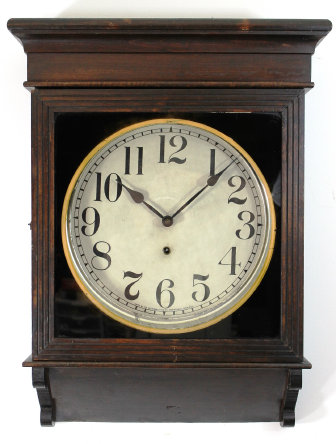
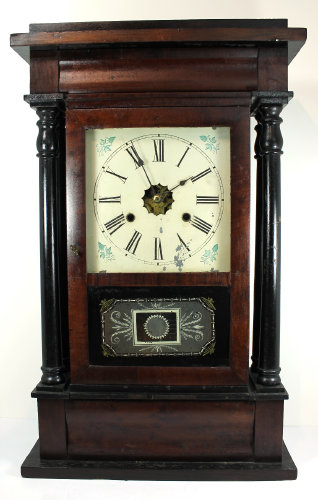
307. $100
Bloomer & Sperry “Rosewood and Mahogany Pillar Clock”, 1845-1846. Bloomer and Sperry sold
clocks out of New York for just two years and there are only two clocks listed under them in the Antique Clocks Price Guide, both
4-column clocks like this one. The Fenn-style glass is the main attraction here, and the upper glass is probably also original. The paint on the black trim pieces, sides, and columns is certainly very old, and may be original as well. The veneer is mahogany
in good shape, with two small strips missing across the front below the door. The metal dial is period but probably not original. The 30-hour time-and-strike, weight-driven movement is signed “Chauncey Jerome, New Haven” and is running and striking reliably. The thin weights are no doubt original, and there is a good paper label inside. It stands 26 inches tall. This particular
collector was on a mission to collect as many maker labels as possible from the 1800’s, and so this clock represented a fairly rare
example from this duo. We estimate $125-$175.
308. $375
Wm. Gilbert “Salisbury”, ca. 1900. You won’t find this clock in Ly’s book on Gilbert clocks
but it is clearly labeled “Salisbury | Wm L Gilbert Clock Co.” on the back. There is also one sales record in the Antique Clocks
Price Guide, for $650 at Schmitt’s in 2009. Clearly an uncommon clock. The 41-inch walnut case is in fine shape, possibly
with the original finish or a very old refinish. There are lots of carvings on the case and everything looks original, from
the case to the dial to the glass, 8-day time-and-strike signed movement, pendulum stick and bob. We replaced the badly worn
paper dial. The glass is old but the silver stencil shows virtually no wear; it may be a re-stencil. The clock is running,
keeping time, and striking on the hour and half-hour on the cathedral gong. A Salisbury sold on eBay in April of this year for
$375. $375-$450.
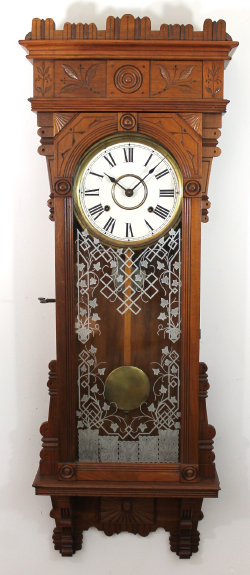
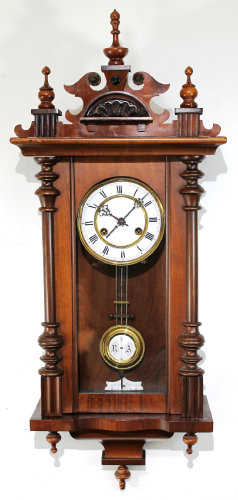
309. $125
Friedrich Mauthe Vienna. The spring-driven movement for this small Vienna is probably early
twentieth century. It has a D.R.P. (Deutsche Reich Patent) number, the FMS (Friedrich Mauthe Schwenningen) logo, and a German
eagle logo. I am less sure about the age of the case, which appears to be late twentieth century; the Mauthe Company was in
business until 1976. The case length, from finial tip to tip, is about 31 inches. The veneer is in nice shape; there are
two side glasses. The 8-day movement is running and striking a wire gong on the hour and half-hour. A nice little Vienna
at a nice price. $150-$225.